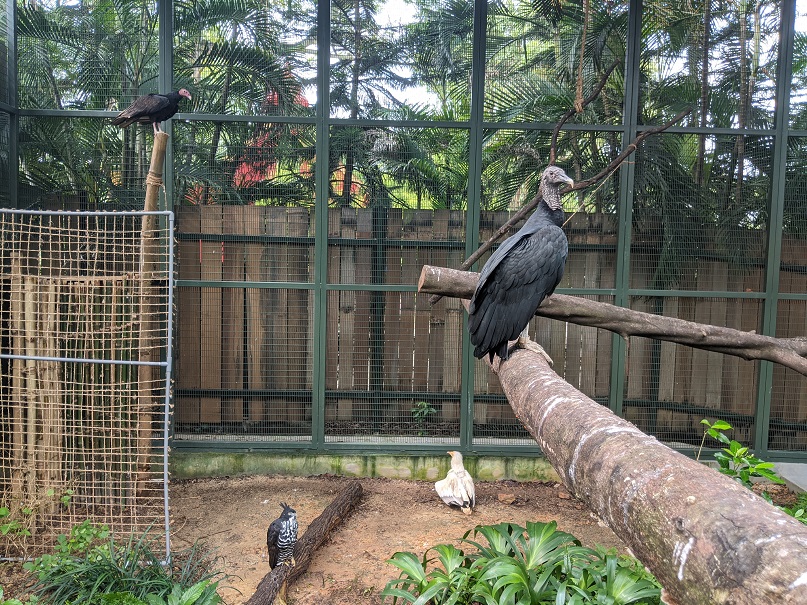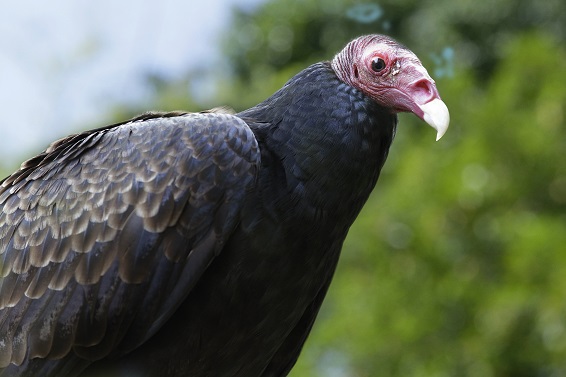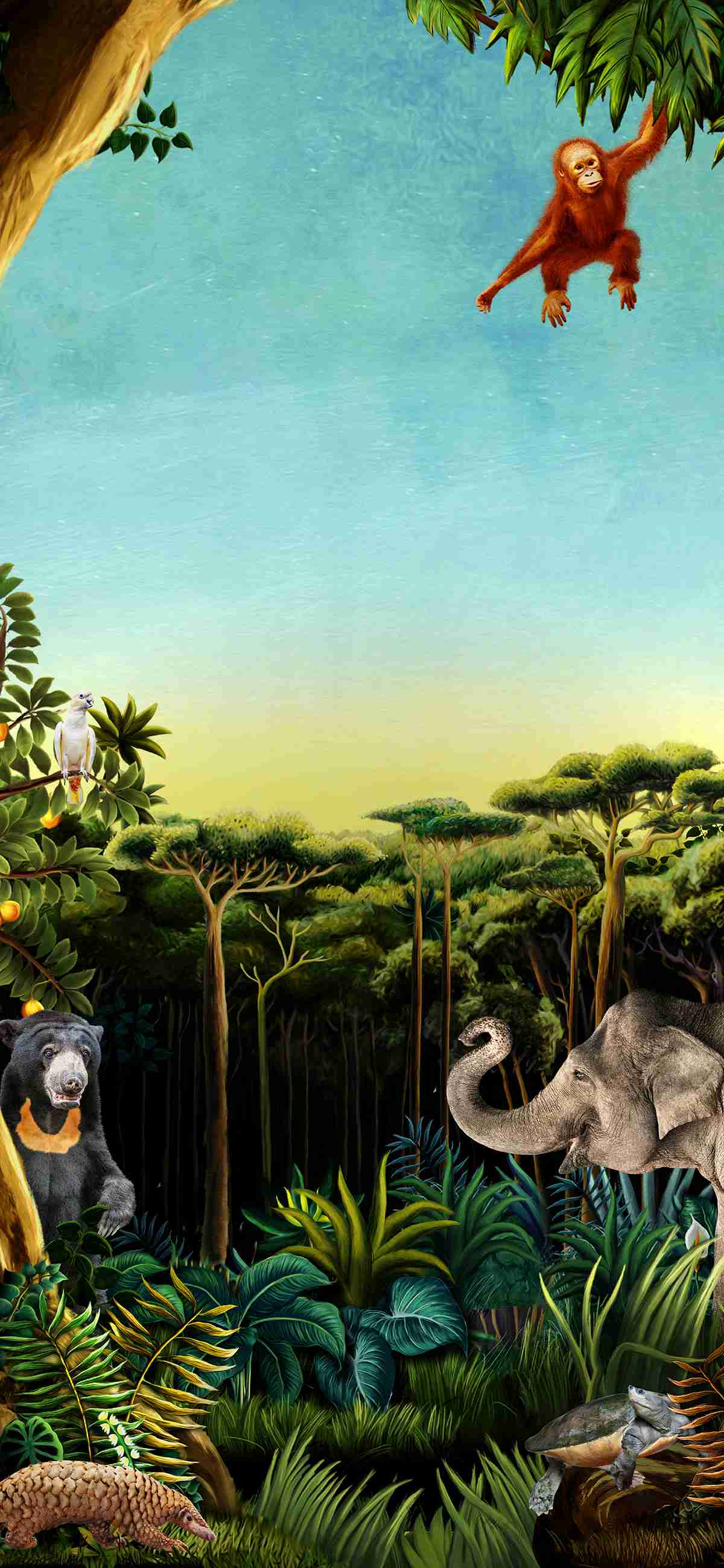Jurong Bird Park sets up retirement home for senior birds
15 Oct 2020Hatched in the early 1960s, Rod Stewart the Egyptian vulture is Jurong Bird Park’s oldest bird and resident of the retirement aviary. Rod wears a cloth bib around his chest to prevent him from picking at an old wound.
PHOTO CREDITS: WILDLIFE RESERVES SINGAPORE
 Four different species of birds of prey seen cohabiting amicably at the new retirement aviary specially built to house the retired birds from the Kings of the Skies show. The aviary features branches and rope perches strategically placed at varying heights to suit the individual needs and movement capabilities of its senior residents. Positive interactions between the species also make for enrichment to keep the birds physically and mentally stimulated.
Four different species of birds of prey seen cohabiting amicably at the new retirement aviary specially built to house the retired birds from the Kings of the Skies show. The aviary features branches and rope perches strategically placed at varying heights to suit the individual needs and movement capabilities of its senior residents. Positive interactions between the species also make for enrichment to keep the birds physically and mentally stimulated.The mixed-species aviary is home to eight birds of prey across six species including eagles, owls and vultures. In planning for the exhibit, the animal presentations team also looked into ensuring the birds had compatible personalities to encourage positive interactions and coexist amicably. Inter-species interactions between the inhabitants create a more dynamic space with higher activity levels, which makes for enrichment to stimulate the aging birds mentally and physically.
As former stars of the iconic Kings of the Skies show which showcases the birds’ natural high flying behaviours, the residents of the retirement aviary are ambassador animals that have played an integral role in raising awareness of threats faced by their wild counterparts and spreading conservation messages to guests. While they have since retired from the limelight, these retirees continue to lead a good life in their golden years under the watchful care of their keepers.
Without the trials and tribulations in the wild of having to fend off predators, diseases or struggling to find enough food, and having access to all the essential life resources and top notch health care, animals under human care tend to live longer compared to their wild relatives. Across Wildlife Reserves Singapore (WRS)’s four wildlife parks, all animals that have reached 75 per cent of their expected life-span are placed under a senior animal care plan. Under this plan, senior animals get specialised care through customised diets, individually tailored exercise regimes and more regular visits from the vets. Under the senior animal health plan, the birds are given a full veterinary health check every six months. They are also visually assessed by keepers and vets regularly to look out for any health or mobility issues. Many of the residents in the retired bird aviary have some form of common age-related ailment and are put on medication regimens to help alleviate these issues.
Dr Cheng Wen Haur, Deputy CEO and Chief Life Sciences Officer, Wildlife Reserves Singapore said, “Like humans, animals face similar aging health issues such as arthritis, muscle atrophy, vision and hearing loss as they get older. Our senior animal care plan seeks to improve the ‘healthspan’ of the animals by slowing the onsets of these age related diseases and to ensure the aging animals continue to have a good quality of life as they enter their twilight years. By opening the aviary to public, we hope guests can appreciate these elderly animals and learn how modern zoos care for them.”
The oldest resident is Rod Stewart the Egyptian vulture. He is estimated to have hatched in the early 1960s making him close to 60 years old, way beyond the 21-year lifespan for the species in the wild. Eagle-eyed guests will spot a white bib that he wears across his chest. This prevents him from picking at an old wound. Besides that, Rod remains spritely for his age and likes to roam about the ground level of the exhibit.
Carlos and Jose the American black vulture siblings were hatched in 1998. The 22-year-olds are well into their retirement years and both siblings receive daily medication hidden in their food to manage the arthritis in their feet and to keep them active. They are otherwise in good physical condition, preferring to fly to the higher perches of the aviary.
Sydney the Blyth’s hawk eagle hatched in 1989. The 31-year-old has severe cataracts in both eyes that are inoperable due to a previous neurological disease. While this renders him functionally blind, he has learnt to maneuver around his surroundings comfortably and is usually spotted moving around the ground level and lower perches of the aviary. He is healthy and not on medication for other ailments.
Other senior birds in the aviary include International the turkey vulture and Caltex the brahminy kite. Rounding up the list of residents are younger birds Max the Eurasian eagle-owl and Wally the brahminy kite who are currently undergoing rehabilitation treatment and under close observations from the animal care team.
Rod the close to 60-year-old Egyptian vulture stretching his wings on a tree stump after being introduced in the new aviary. He is still spritely for his age, choosing to bound about the floor and lower perches of the aviary.
PHOTO CREDITS: WILDLIFE RESERVES SINGAPORE
Dr Ellen Rasidi, veterinarian, gives Jose the American black vulture a physical check and blood draw while Senior Trainer Syawal Bin Safi’ee holds onto the bird before releasing it into its new home in the retirement aviary.
PHOTO CREDITS: WILDLIFE RESERVES SINGAPORE

Carlos the American black vulture is the brother of Jose. Both siblings are on daily medication to manage their arthritis but are otherwise happy and healthy ruling the higher perches in the retirement aviary.
PHOTO CREDITS: WILDLIFE RESERVES SINGAPORE

Sydney the 31-year-old Blyth’s hawk eagle is functionally blind from severe cataracts. Despite this, he is comfortable roaming the lower perches of the retirement aviary.
PHOTO CREDITS: WILDLIFE RESERVES SINGAPORE

International is a 22-year-old turkey vulture, a species named for its bald and reddish head resembling that of a turkey. Retiring from the Kings of the Skies show in 2020, he wil enjoy his golden years in the retirement aviary.
PHOTO CREDITS: WILDLIFE RESERVES SINGAPORE
Max the Eurasian eagle-owl was hatched in 2010. While a younger bird in comparison to the rest of her peers in the aviary, she is undergoing rehabilitation for scoliosis and uses the space in the aviary to regain her strength to walk, run and fly.
PHOTO CREDITS: WILDLIFE RESERVES SINGAPORE

Wally and Caltex are a pair of brahminy kites. 10-year-old Wally has an old injury on his left shoulder that prevents him from flying long distances or doing the aerial maneuvers that brahminy kites are known for. He can still fly short distances and lays claim to the highest perches in the aviary.
PHOTO CREDITS: WILDLIFE RESERVES SINGAPORE

Wally and Caltex are a pair of brahminy kites. Caltex is the senior of the two at 17 years old.
PHOTO CREDITS: WILDLIFE RESERVES SINGAPORE

